Red-eared sliders have a reputation for being some of the easiest turtles to care for in captivity. They are very hardy pets that can be kept even by beginner turtle enthusiasts. However, red-eared sliders cannot survive in setups that are less than ideal, so proper care is necessary to keep them alive and healthy.
Many people prefer to keep their red-eared slider turtles indoors because this provides them with a more secure environment than an outdoor pond can offer. So, if you are planning on keeping your red-eared slider indoors, you need to make sure you know how to set up the proper environment for her. That’s where this article comes in! I’ve laid out everything you need to know about providing a suitable setup for your red-eared slider turtle indoors.
How Do You Care For Red-Eared Slider Turtles?
Red-eared sliders originate from North America, particularly from the Southeastern region. They are experts at surviving in a wide range of habitats but prefer to live in shallow ponds with little vegetation and varied substrate. This makes it difficult to properly recreate their natural habitat indoors.
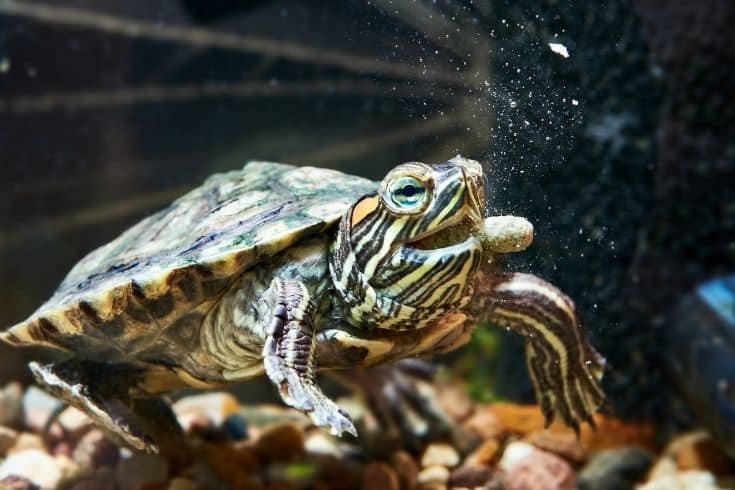
In an outdoor environment, red-eared sliders are kept in ponds. The best way to care for these turtles is to keep them in a water environment with a deep enough base that they can swim around in comfortably. Newborn red-eared sliders have an instinctual drive to swim, but baby red-eared sliders raised indoors may not get the chance to engage in this important activity.
One of the main reasons people keep red-eared sliders indoors is to make it easier to give them a proper basking spot and UVB lighting. However, even when kept indoors, red-eared sliders must also be provided with aquatic habitats. This means that they need both water and land areas in which they can live.
Since it is not easy to recreate a natural pond indoors, providing your red-eared slider with both land and water areas necessitates the creation of an indoor habitat for her. You can never recreate exactly what she would have in nature, but you can at least create an aesthetically pleasing environment that will encourage her to engage in normal behaviors.
Let’s now go over the various elements you need to provide for your red-eared slider turtle indoors. But first, let’s talk about what kind of enclosure you should use and how large it needs to be.
Best Tank Size For A Red-Eared Slider Turtle
When it comes to your aquatic turtle habitat, a larger tank is always better! Since turtles need plenty of space to swim around, invest in the biggest size tanks you can afford. Like us, red-eared sliders need a living space that allows enough room to move around. A lack of space will cause your turtle to become bored and will reduce their quality of life, so please be sure to provide them with plenty of room!
For red-eared sliders, the general rule of thumb is to give them at least ten gallons of water per inch of their shell, so if your turtle is 10 inches long, you will need to consider a 100-gallon tank. For every additional turtle you house in the same tank, you should increase the size of the tank by at least 20 gallons. Yes, this means that in all likelihood, you will need to get a tank that is many times larger than your typical fish tank.
Many turtle keepers find it difficult to set up a tank that large, particularly if limited space is an issue. If this is the case, then please opt for a different species of turtle. Red-eared sliders are known to grow up to 16 inches long, so do the math before you pick up one of these turtles! Once you commit to taking care of a red-eared slider, you are also committed to providing her with optimum space.
Creating Your Red-Eared Slider Tank Setup
Once you have acquired a spacious tank for your red-eared slider, it’s time to set up her new home. A semi-aquatic turtle, red-eared sliders are turtles that spend plenty of time in the water, but they also need extra space in the form of a dry land area. This is why a tank with decorations that allow your turtle to climb out of the water is a must! Smooth rocks make a nice option, as do driftwood and sturdy rooted plants.
Some hobbyists struggle with keeping plants inside turtle tank setups, causing them to opt for plastic plants in lieu of real plants. Unfortunately, fake plants and plastic tank decorations can harm your pets. All it takes is a sharp edge or any other kind of manufacturing defect to cause a turtle to become injured. Please keep this in mind and be sure to choose tank accessories carefully!
In lieu of plastic decor, we highly recommend opting for live plants in your turtle tank setup. Live plants will not harm or injure your turtles, and they will also help keep the water clean by filtering out toxins like ammonia. A popular choice for turtle tanks are water lettuce, which are incredibly easy to maintain. To ensure healthy growth, provide your water lettuce with plenty of low-light. And if you’d like to introduce other plant species into your tank, check out our list of top turtle tank plants!
Though we’ve provided some tips on how to keep your plants alive and healthy in a turtle tank, some enthusiasts may still be struggling with plant growth. Under these circumstances, it’s normal to wonder if aquatic plants are necessary. The answer would be no, but we do believe they make a quality addition to your turtle tank setup. So give it your best shot! It’s well worth the effort.
Do Red-Eared Sliders Need A Substrate?
Another question that tends to come up is whether or not you should put a substrate in your turtle tank. Some people believe that turtles love to use their shells as a tool, and by putting a substrate in the tank it reduces this natural behavior. In our experience, red-eared sliders don’t use shells as tools all that often, but putting a substrate in the tank will still be beneficial. Because red-eared sliders love to dig around, a substrate can provide mental stimulation for your pets.
As far as what type of substrate you should use in your turtle tank setup, we recommend using aquarium sand or an organic topsoil that is made for planting. Never use anything with sharp edges, like crushed coral. This type of substrate can cause injuries to your turtles if accidentally ingested. Gastric impaction and even death can result if your turtle ingests sharp materials like this.
Once you’ve taken safety into account, know that red-eared sliders aren’t too picky with the type of substrate that goes into their tanks, but do best with something that is anywhere from 3-6 inches thick, with larger rocks interspersed throughout to provide basking areas. This will also prevent your red-eared slider from digging too deep into the substrate, which can lead to infections of the shell.
A substrate-less tank setup can also be used for red-eared sliders. This is the best option if you’ve got a sick turtle, as it will limit your pet’s exposure to bacteria and other harmful pathogens that can live in substrate. However, a substrate-less setup does not provide your pets with any mental stimulation. So if you do opt for this type of tank, be sure to include plenty of toys and other kinds of turtle accessories that will keep your pets mentally stimulated and healthy!
Let’s Talk Diet
A red-eared slider’s diet is also a concern when you’re setting up their new home, as the wrong type of food can lead to health problems.
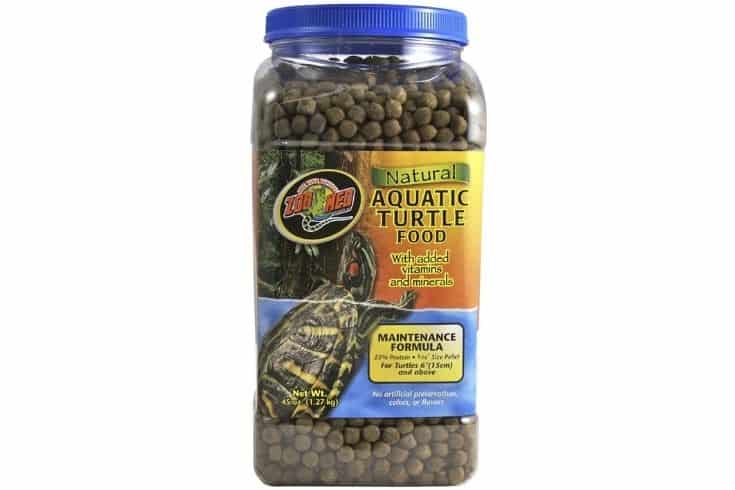
Red-eared sliders need an omnivorous diet, which means that they like to eat both meat and vegetation. We recommend feeding them a combination of pellets (we like ZooMed’s Natural Aquatic Turtle Food) and live foods like earthworms. This will provide your red-eared slider with all of the nutrients it needs to be healthy.
If you’re looking for food that is packed full of calcium, ZooMed’s Calcium Plus pellets are your best bet. These pellets have added calcium that will strengthen your red-eared slider’s shell, and can even help them develop stronger bones in general. Believe it or not, turtles need calcium to be healthy just like humans.
For red-eared sliders that are younger than six months old, it’s important to feed them every day. However, after they turn one you can start reducing the number of times you feed them to two times per week. This will help your turtles grow stronger shells and bones as they age.
Best Indoor Setup For Red-Eared Sliders: Other Tips
Now that we’ve covered the basics of turtle tank setups, let’s cover some general tips for keeping red-eared sliders inside.
Use A High Quality, Powerful Filter
Loveable as they may be, we all know that red-eared sliders can be messy animals, which is why a powerful filter is a must, particularly when housing multiple turtles in the same tank. Not only do filters keep your turtle tank clean, but they also prevent health complications and health issues by eliminating waste and ensuring that the water is clean and free of toxins.
There are many types of filters on the market, so it helps to understand the differences between the various types. Here’s a quick refresher:
- Canister filters are great for turtle tanks, particularly if you have larger enclosures such as a 100-gallon turtle tank. You don’t necessarily need an amazing canister filter for a turtle tank, but the filter should filter out solid waste, circulate water well, and keep the water clean. Expect a decent canister filter to cost anywhere from $100-$300.
- Power filters are a good choice for smaller tanks, such as 55-gallon turtle tanks. These filters clean the water well and allow for more filtration of smaller particles. They’re also easy to maintain, relatively quiet, and cheap!
- Hang-back filters work by adhering to the back of your tank. They do a great job at keeping water clean, but they’re not as powerful as canisters or power filters. However, they are much easier to install compared to submersible filters, making them a good choice for beginners that want an easier setup.
- Sponge filters are incredibly basic and easy to find, making them a popular choice for turtle tanks. Although they do a good job at filtering out waste, they don’t filter out smaller particles as well as other filters. To make up for this shortcoming, you’ll need to change your filter frequently.
- Last but not least, corner filters are very basic and should only be used in smaller turtle tanks. They’re easy to install but aren’t incredibly powerful or efficient.
No matter which type of filter you choose, go for the best. Weigh the pros and cons of each type, and choose a filter that will keep your turtle tank clean at all times.
Maintain An Ideal Water Temperature
Many turtle owners make the mistake of not maintaining an ideal water temperature in their turtle tank, which is a huge problem. Turtles are cold-blooded animals, which means they rely on their environment to regulate their body temperature. If the water in your turtle tank is too hot or too cold, your red-eared slider will be stressed out and susceptible to illness or disease.
To maintain a constant temperature in your turtle tank, we recommend using turtle tank heaters with an adjustable temperature controller that will allow you to fully control temperature settings, particularly for larger turtle tanks. A decent water heater will cost anywhere from $50-$150.
Also, it is a good idea to learn about the various types of heaters that are available on the market, so that you can choose a heater that will best fit your turtle tank. In general, turtle enthusiasts recommend glass aquarium heaters because they are much more reliable than submersible models. The latter needs to be carefully regulated, while their glass counterparts are able to adjust the water temperature quickly and accurately.
The final piece of the puzzle is a digital aquarium thermometer that will allow you to accurately measure water temperature. Not only will this help you ensure that your heaters are placed within their operating temperature ranges, it also ensures that your water temperature is constantly monitored and maintained at a safe level.
Make Sure There’s Enough Water For Swimming
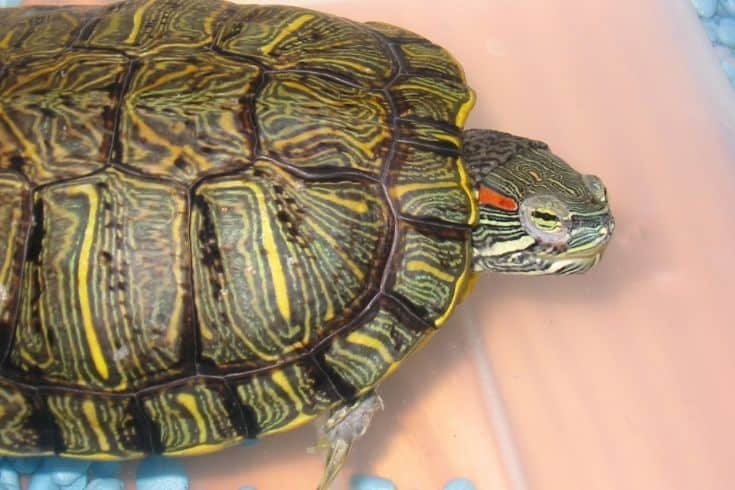
Yet another important thing you need to focus on when setting up a turtle tank is water. Red-eared sliders are strong swimmer turtles that can grow up to a foot and half in length. Because of this, they need plenty of water to swim around in, using their current size as a guide.
Generally speaking, the minimum water depth of your turtle tank should at least be 4-inches deeper than the height of the turtle. Red-eared sliders enjoy a bit of vertical swimming every now and then, so this 4-inch depth allocation will provide them with the freedom they need to swim around. But keep in mind, if you want your red-eared slider turtle to grow even larger, then you should consider adding even more depth (6-inches is ideal).
Considering that the average size of a red-eared slider turtle is between 8 to 12 inches, a shallow tank simply will not do. Realistically, you’ll need to set up your turtle tank with a water depth of at least 2 feet. However, if you plan on housing more than one red-eared slider in the same tank, then you’ll need even more depth to accommodate all of them.
The good news is that it’s fairly easy to achieve these goals with most turtle tanks because they already come standard with a raised stand. A common mistake turtle owners make is using a tank that’s not wide enough to include a separate area for water depth. So remember, be sure to measure the length and width of your existing tank before purchasing any additional aquarium equipment.
Invest In A Decent UVB Light
Though not as important as proper tank heating and water depth measurements, we also recommend that you invest in a decent UVB light for your turtle. Fluorescent UVB lights are great for turtle tanks because they help to create a healthy environment that mimics the conditions found in their natural habitats. These types of lights also promote vitamin D3 synthesis, which is essential for your turtle’s bone development.
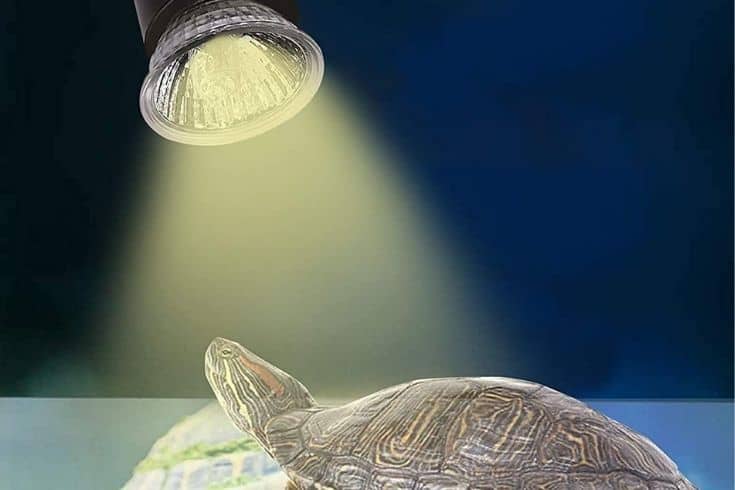
This is particularly true for water turtles, whose shells are highly porous and need constant replenishing of calcium to stay healthy. Turtles absorb UV spectrum lights through their skin and shells for vitamin D3 synthesis, which helps them properly metabolize calcium. If your red-eared slider lacks access to UVB lighting, they may develop metabolic bone disease, which can severely harm their health and shorten their lifespans.
The easiest, most efficient way to allow your red-eared slider turtle to absorb UVB light is by purchasing a UVB bulb. This type of bulb is specifically designed for turtles, so you won’t have to worry about your turtle’s skin or shell absorbing too much ultraviolet light. The only downside to UVB lighting is that they need replacing after 6-months to be effective.
In addition, if aesthetics are a concern, you can also opt for a stylish lamp with UVB lights. These lamps are manufactured to blend in nicely with your turtle tank without drawing too much attention to themselves, creating nice, diffused light that is near-impossible to replicate with conventional spot lighting. Though they may both work, we recommend that you stay away from spot lighting.
Create A Basking Area
We’ve touched briefly on the red-eared slider’s need for a basking area in our introduction, but we wanted to elaborate on this because it’s such an important element of your tank environment. Turtles rely heavily on basking areas to regulate their body temperature and properly digest their food. Otherwise, your red-eared slider turtle may suffer from a lack of appetite or digestion issues.
In their natural habitats, turtles will bask in the sun to absorb heat, but if they don’t have access to a habitat with sunlight, you need to create one for them by using heat lamps. Using light for heat will mimic natural basking conditions, allowing your turtle to properly digest their food and increase their metabolic rates. This is particularly important in the winter when the ambient air temperature is lower.
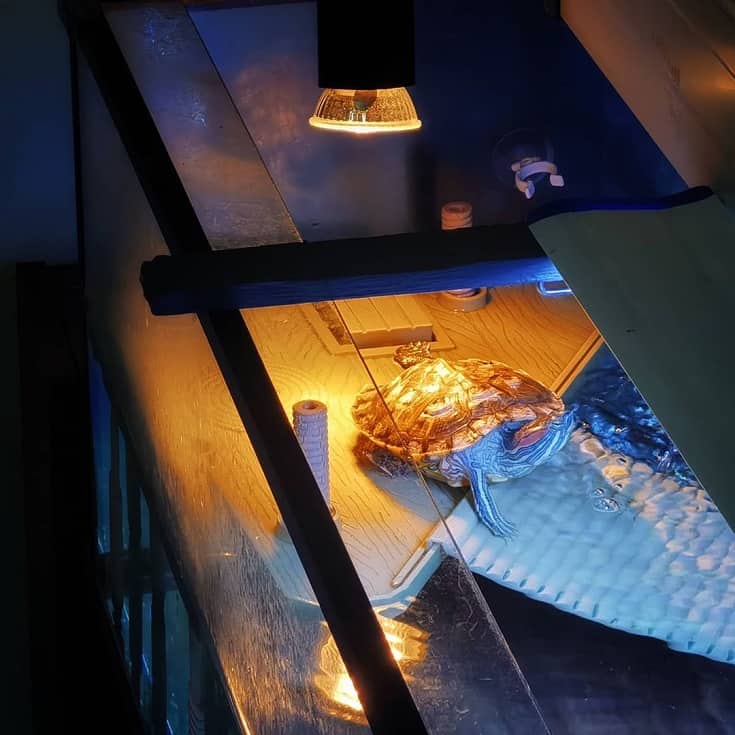
Some hobbyists may wonder if the UVB lights mentioned in the previous section can double as a heat lamp. The truth is, they can’t. A UVB light is simply that – a bulb that emits ultraviolet spectrum light. This is helpful, but your pet will also need a dedicated light for reptiles that emits heat. You can achieve this by purchasing a supplemental heat lamp or by opting for a combo light, which carries both heat and UVB properties.
Of course, all the heat lamps in the world wouldn’t make a difference if the air temperature of your pet’s surroundings is simply too low. If the air in your home is chilly, you should consider using a heater along with your heat lamp. Take daily temperature readings and adjust the intensity of your heat lamps accordingly. And above all – avoid having your temperature swing widely from hot to cold, as this will cause your pet unnecessary stress.
Only Purchase Reliable Turtle Tanks
This may sound a little obvious, but we have seen plenty of pet owners purchase a tank for their turtle only to find out they’ve been duped by slick marketing. In short, turtles need a sturdy tank that can keep them secure and protected. A quality tank can go a long way in keeping your red-eared slider healthy and happy, so always remember to look for reliable turtle tanks from a reputable manufacturer. Check out our list of top recommendations, if you’re looking for ideas!
The difference between fish tanks, reptile tanks, and terrarium tanks lies in their size. A fish tank is designed for sleek, elegant fish that don’t grow too large, while reptile tanks are made for growing turtles and various other reptiles. These tanks can last you several years as your pet turtle grows, which means you’re investing in the turtle’s long-term health.
In addition to a sturdy, reliable tank, your red-eared slider will also need a secure cover. Turtles are incredibly gifted swimmers and can escape from virtually any enclosure if they want to, so make sure your turtle’s tank has a secure lid with no tiny cracks or openings where their little necks can wiggle through. If you have a wide tank, you might need to purchase a secondary lid that can cover the open gap.
The type of tank covers used may vary. Some owners like to use plexiglass tank covers, while others may prefer heat-proof metal tank covers. The material doesn’t matter as much as the security of the lid itself, so make sure it isn’t too flimsy or fragile before you buy it. And keep in mind that turtles are adept at breaking free, so you may need to replace the tank cover from time to time.
Do Baby Turtles Require A Different Kind Of Setup?
When it comes to babies, you will need a slightly different setup. Babies are much smaller than adults and require less heat (for now), so the first thing you’ll want to do is make sure your baby turtle tank has low levels of water on both ends of the enclosure. This will keep them safely on land while still allowing them to swim and breathe.
You will also want to monitor the temperature of your baby’s habitat closely, as little red-eared sliders grow faster than larger turtles. They can quickly reach a high risk for burns or illnesses if the enclosure is too hot, which means you’ll need to keep an eye on your thermometer and adjust heat levels accordingly. Eventually, they will grow out of this stage, but it’s important to be very careful with babies.
Another thing you will want to do is check for drafts and make sure your baby turtle enclosure isn’t too cold. To accomplish this, put a pile of towels on the bottom of the tank and allow them to soak up all the cold air around your pet before putting him in there. This will help keep him cozy and safe during those early days.
Final Thoughts
Caring for a red-eared slider indoors can be a rewarding experience, but it’s important to remember that owning any pet is a huge responsibility. The setup we described here is only a framework, and every turtle owner has their own needs and preferences. The key is to do your research and find a safe enclosure for your red-eared slider.
We hope that this article has been helpful for all turtle owners out there. If you have any questions or need clarification – or if you simply want to share your setup – please post in the comments section below. And if you know a friend or family member who is looking for a pet turtle, please share this article with them. We love hearing from you, so please drop by from time to time.
Until next time, happy turtle keeping!
